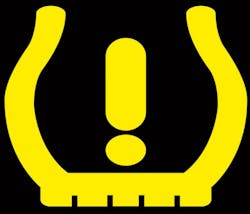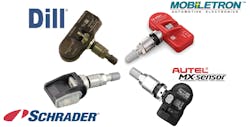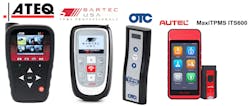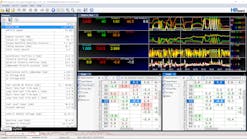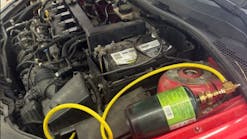Content brought to you by Motor Age. To subscribe click here.
What You Will Learn:
- The two different main types of TPMS systems
- How/why TPMS systems are required by law
- What characteristics can be helpful when choosing TPMS tooling
When discussing the subject of tire pressure monitoring systems (TPMS), it’s something many technicians (or shops for that matter) don’t typically put too much thought into. They treat it as one of those necessary evils that just come with the territory of running a service and repair business. It’s not typically thought of as being profitable, as much as it is a task that just must be dealt with when, say, replacing tires.
The truth of the matter is being adequately prepared to deal with TPMS systems can truly be a profitable venture.
A step back in time
We likely know that TPMS came to be popular around 2007, when the TREAD Act (which was introduced in 2000 to address issues of severe tire failures from inadequate tire pressure) required TPMS to be installed on all new model vehicles under 10,000lbs GVW. Now that they are no longer an option, these systems must now be faced head-on by techs and shop owners.
Early systems (known as “indirect TPMS”) capitalized on the Antilock brake system (ABS) to calculate tire pressure. The pressure in the tires was simply inferred (not measured). As a tire loses pressure, the outer circumference of the tire lessens as well. As a result, a complete rotation of that tire occurs over less of a distance, meaning the tire will rotate faster than one that is pressurized appropriately (Figure 1).
A system like this can be found on some vehicles dating back to the 1980s! The wheel speed sensors of the ABS system will report this data to the ABS control module. That same data is used (by comparing the pressures of tires diagonally from one another) to trigger the TPMS warning indicator if a threshold is exceeded. The point is this data was extrapolated from an existing system. There was not much needed as far as tooling goes to service, diagnose, and repair these early indirect TPMS systems. Simply driving vehicles under certain operating conditions was all that was necessary to relearn the system.
Again, the point is anybody could do it. This information was simply for a means to illuminate a warning light, alerting the driver to a tire with low pressure (25 percent lower than placard specification). Although these systems could detect the underinflation of a few tires, they were unable to calculate the underinflation of all four tires. It’s for this reason the game had to change.
Later systems utilized sensors that would output TPMS data. This information was not inferred but was being measured by the sensor. The sensors not only reported pressure but also included temperature, battery life, and individual sensor identification.
Data was broadcast as a wireless signal from the sensor at a frequency of either 315 or 433 MHz (in the United States), and these two radio frequencies were not interchangeable. Because this data was no longer inferred, it was far more accurate. We refer to this method of reporting as “direct TPMS”.
The sensor could be found as one that attaches to the wheel rim (just as conventional tire valves do) or could be tethered to the wheel with a clamp or tension band. Depending on the configuration of the system, one or more transmitter/receivers (transceivers) would receive and process the TPMS data from the sensors and possibly relay it to an ECU (if it were not integral to the ECU). Again, all the system was required to do was report if a tire were underinflated; however, some of these systems could also identify a specific tire. There are many sensors available in the aftermarket (Figure 2).
Later systems evolved again and went back to the indirect system, however, with far more accurate algorithms used to detect tire pressure differential. As interesting as a topic that is in and of itself, it is not what I am going to focus on here.
When it came to service and repair, a simple rotation of the tires could call for a relearn of the TPMS system. ECUs (electronic control units) are not smart; they are just programmed to process data swiftly and perform specific functions as a result. We would have to indicate to the ECU that the ID numbers for each sensor would now be in a new location. That is exactly what the relearn procedure provided.
Many times, that procedure was carried out by a simple button push (located somewhere in the cabin or under the hood). Later systems incorporated initiators that would “ping” the sensors and allow them to self-identify their location to the TPMS system ECU.
The goal of the TPMS is system is to alert the driver of an underinflated tire. When detected, it would cause the system to illuminate the TPMS warning indicator steadily (Figure 3). Now, during a malfunction of the TPMS system, a different indication was given to the driver.
This could be a separate warning indicator or the same indicator (now “flashing” instead of being illuminated steadily). This would require further diagnosis to determine not only the issue, but also which tire was related to the fault.
As sensors begin to age, so too do the batteries that power them, and they are non-serviceable. When it comes to replacement (to preserve battery life), the sensors, shipped as replacement parts, were dormant, or in an “off mode". These sensors had to be initialized to begin outputting data. Some sensors simply had to see a change in pressure to be initialized. Others required a TPMS activation tool that was used to ping the sensor (typically at a low frequency, 125kHz frequency) so they would function. In some situations, a magnetic device could be used to perform this same task This is where tooling started to come into play.
Time to invest-Getting the most bang for your buck
TPMS diagnosis is no different than any other system being analyzed on a vehicle. It requires an understanding of the components and how they interact with one another but equally as important as having the tools to do the job to completion.
Scanning for DTCs
Verifying the sensors' function (can output data accurately)
Making sure the tires are inflated to proper pressure (specification on tire placard)
Finding the root cause of the fault being detected by the ECU
Performing the repairs necessary to correct the fault
Clearing the DTCs
Relearning the TPMS system
Verifying the proper operation before returning the vehicle to the customer
Again, it is just like any other diagnosis/repair procedure we perform, but we must have the tools to do the job to completion. There are many tools on the market today that can handle those above tasks. However, keep in mind that not every vehicle is configured the same. Therefore, not every tool will work on all vehicles (Figure 4). As I stated in the beginning, having the ability to complete the job is just part of the equation. Being able to do so profitably is the other factor.
Choosing tools that can tackle those above tasks on a large variety of vehicles is what I am interested in as a technician in today’s ever-evolving world (Figure 5). I need the tools to overcome the challenges I face today, but what about the ones I face tomorrow? Selecting a tool that will be functional on only a few vehicle lines, or whose software updates cost a small fortune is something I try to avoid like the plague.
I want the tools that can do the job today, tomorrow, and efficiently. I do not think that is too much to ask. Rather than spending time researching service information, consider a tool that has guided step-by-step instructions on the vehicle you are addressing.
I would much rather be fishing with a net, rather than a hook; it’s simply more efficient. Consider a tool that could perhaps scan a VIN. Everything you would need to know about that TPMS system for that vehicle could arrive at your fingertips instantaneously. That would certainly save some time.
Consider the list of bullet points above. To complete that full list of tasks, how doable is it when we are addressing multiple vehicle makes and models? Think of the investment in tooling required to tackle them all (and the software, as mentioned earlier), not to mention the time required to familiarize yourself with all the different tools and how to navigate them.
Having one tool that would cover all (if not, almost all) makes and models is definitely attractive to me, but what if you had a tool that would also carry out that entire process on all makes and models (say 99 percent of them)? That would be a game-changer, for sure!
The next challenge that comes to mind is sensor replacement. As mentioned earlier, vehicles are looking for a certain frequency to recognize the data being output from the sensors. Think of the inventory selection you would need on hand to cover the multiple makes/models you would be servicing. If possible, I would choose the sensor that functions for “most applications.”
For an inventory, this would be a safe bet to make. Having a sensor that functions with “almost all” vehicles would certainly limit downtime, boost efficiency, and maximize inventory storage space.
The hunt is on
It’s not just about if the tool functions. It’s not only about cost, either. It must make sense from many angles for it to be a rapid return on investment.
Choosing the tool that I’m going to use often and on most applications is the right tool for me. Do your due diligence and don’t just select a “good tool.” Select the “right tool.” It must be “right” from all angles.
This is how I remain efficient and profitable, but most importantly, confident that I can get the job done right on the customer’s first visit.
